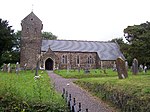Brompton Regis

Brompton Regis (formerly known as Kingsbrompton) is a village and civil parish in the Somerset West and Taunton district of Somerset, England about 5 miles (8.0 km) north-east of Dulverton. It is situated on the River Pulham in the Brendon Hills within the Exmoor National Park, close to Wimbleball Lake, a water supply reservoir constructed in the 1970s and completed in 1979. According to the 2011 census the village had a population of 449. The parish boundary is marked by the River Exe which is crossed by the medieval Chilly Bridge and Hele Bridge. The Haddeo is crossed by Bury Bridge.The parish includes the village of Withiel Florey, where the Church of St Mary Magdalene has 12th-century origins and has been designated as a Grade II* listed building, and the hamlets of Bury, Gupworthy and Hartford.
Excerpt from the Wikipedia article Brompton Regis (License: CC BY-SA 3.0, Authors, Images).Brompton Regis
Sanctuary Lane,
Geographical coordinates (GPS) Address Nearby Places Show on map
Geographical coordinates (GPS)
| Latitude | Longitude |
|---|---|
| N 51.0733 ° | E -3.493 ° |
Address
Sanctuary Lane
Sanctuary Lane
TA22 9NN
England, United Kingdom
Open on Google Maps









